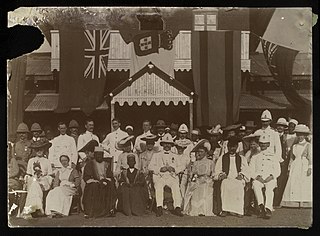
Kampala is the capital and largest city of Uganda. The city proper has a population of 1,680,600 (2020) and is divided into the five political divisions of Kampala Central Division, Kawempe Division, Makindye Division, Nakawa Division, and Rubaga Division.

The Church of Uganda is a member province of the Anglican Communion. Currently there are 37 dioceses which make up the Church of Uganda, each headed by a bishop.
The Anglican dioceses of Buganda are the Anglican presence in the Central Region, Uganda ; they are part of the Church of Uganda. The remaining dioceses of the Church are in the areas of Eastern Uganda, of Northern Uganda, of Ankole and Kigezi, and of Rwenzori.

The Archdiocese of Kampala is the Metropolitan See for the Roman Catholic Ecclesiastical province of Kampala in Uganda.
Nsambya is a hill in the center of Kampala, the capital and largest city in Uganda. The name also refers to the upscale and middle-class neighborhoods that have been developed on the hill and its slopes.
Mengo is a hill in Rubaga Division, Kampala, Uganda's capital and largest city. The name also applies to the neighborhood on that hill.
Lubaga is a hill in Kampala, Uganda's capital and largest city. It comes from the Luganda word okubaga, describing a process of "planning" or "strengthening" a structure while constructing it. For example, okubaga ekisenge means to strengthen the internal structure of a wall while building a house. The name also applies to the neighborhood on the hill.
Rubaga Division, also Lubaga Division, is one of the divisions that makes up the city of Kampala, Uganda. The division takes its name from Rubaga, where the division headquarters are located.
Namirembe is a hill in Kampala, Uganda's capital and largest city. It is also a common name given to girls in several Baganda clans. Namirembe comes from the Luganda word "mirembe" meaning peace. Namirembe loosely translates into Full of Peace. Legend has it that this hill was a gathering place for celebrating peace or war victories.
Naakulabye, also Nakulabye, is a neighborhood within the city of Kampala, the capital and largest city in Uganda.

Mengo Hospital, also known as Namirembe Hospital, is a private, faith-based, community, teaching hospital in Kampala, the capital and largest city of Uganda.

The Bulange (boo-lah-ngeh) is a building in Uganda. It houses the Lukiiko (Parliament) of the Kingdom of Buganda. The Kabaka of Buganda and the Katikkiro of Buganda also maintain offices in the building. The building serves as the administrative headquarters of the Buganda Kingdom.
The Anglican ecclesiastical province of Uganda, Rwanda and Burundi was formed in 1961 following the division of the diocese of Uganda the previous year. Prior to 1980, the province included Uganda, Rwanda, Burundi and Boga, in what was then the country of Zaire. In 1960, the Diocese of Uganda was separated and in 1961 the smaller dioceses made a separate Province, under the Archbishop of Uganda, Rwanda and Burundi: As of June 2012, the Church of Uganda is divided into 34 dioceses and is under the Archbishop of Uganda and Bishop of Kampala.
Mengo Senior School, also known as Mengo SS, is a comprehensive, mixed day school in Kampala. As of March 2020, it had over 5300 students, 250 teachers, 28 technical staff, and more than 30 support staff.

Saint Mary's Cathedral Rubaga, commonly referred to as Rubaga Cathedral, is the parent cathedral of the Roman Catholic Archdiocese of Kampala, the oldest Roman Catholic diocese in Uganda. It is the home church of Archbishop of Kampala.
Namirembe Hill is a hill in Kampala, Uganda.

Janani Luwum Church House, or simply Church House, is a commercial building in Kampala, the capital of Uganda. The building is owned by the Anglican Church in Uganda, known as the Church of Uganda.

Samuel Stephen Kaziimba Mugalu is a Ugandan Anglican bishop. On 28 August 2019, he was elected to serve as the ninth Archbishop of Uganda and Bishop of Kampala, effective 1 March 2020. In his capacity as Archbishop of Uganda, he is the head of the Church of Uganda. Prior to his new position, he served as the Anglican Bishop of the Diocese of Mityana, from 2009 until 2020.
The Anglican dioceses of Rwenzori are the Anglican presence in (roughly) the areas near the Rwenzori mountains; they are part of the Church of Uganda. The remaining dioceses of the Church are in the areas of Buganda, of Eastern Uganda, of Northern Uganda, and of Ankole and Kigezi.
All Saints' Cathedral, Kampala also known as All Saints Church Kisozi is an Anglican cathedral in Uganda. It is the seat of the bishop of Kampala, who serves concurrently as the archbishop of Uganda. The existing cathedral dates to the early 20th century, while a much larger modern cathedral building remains under construction.












